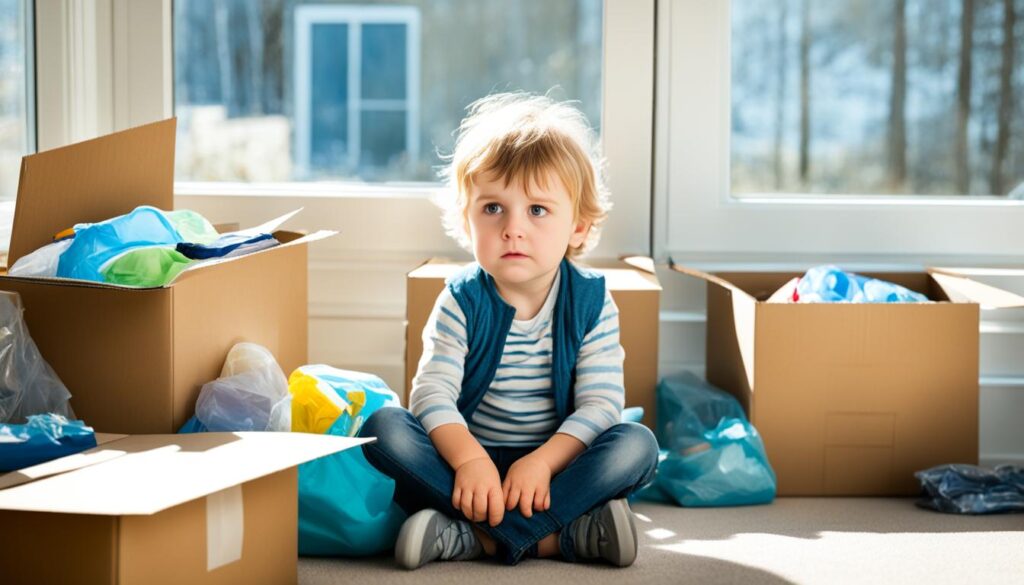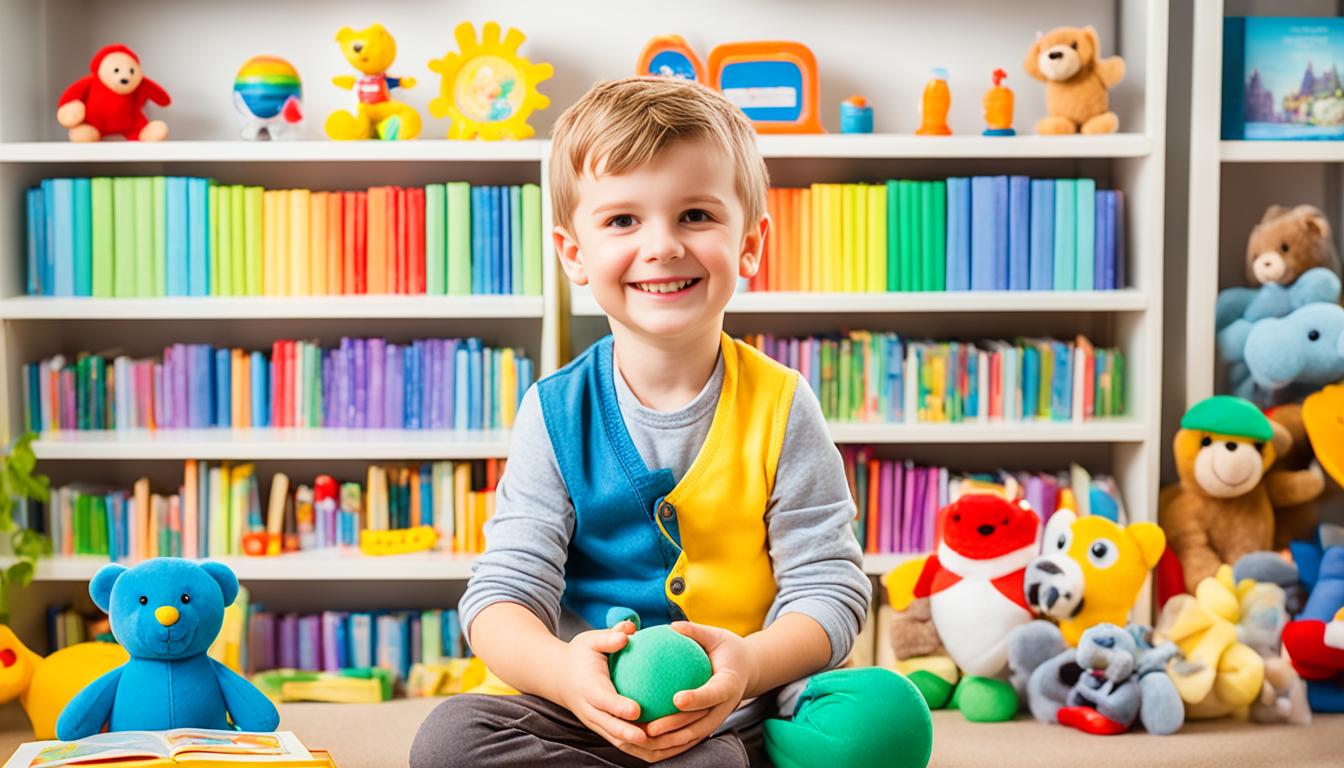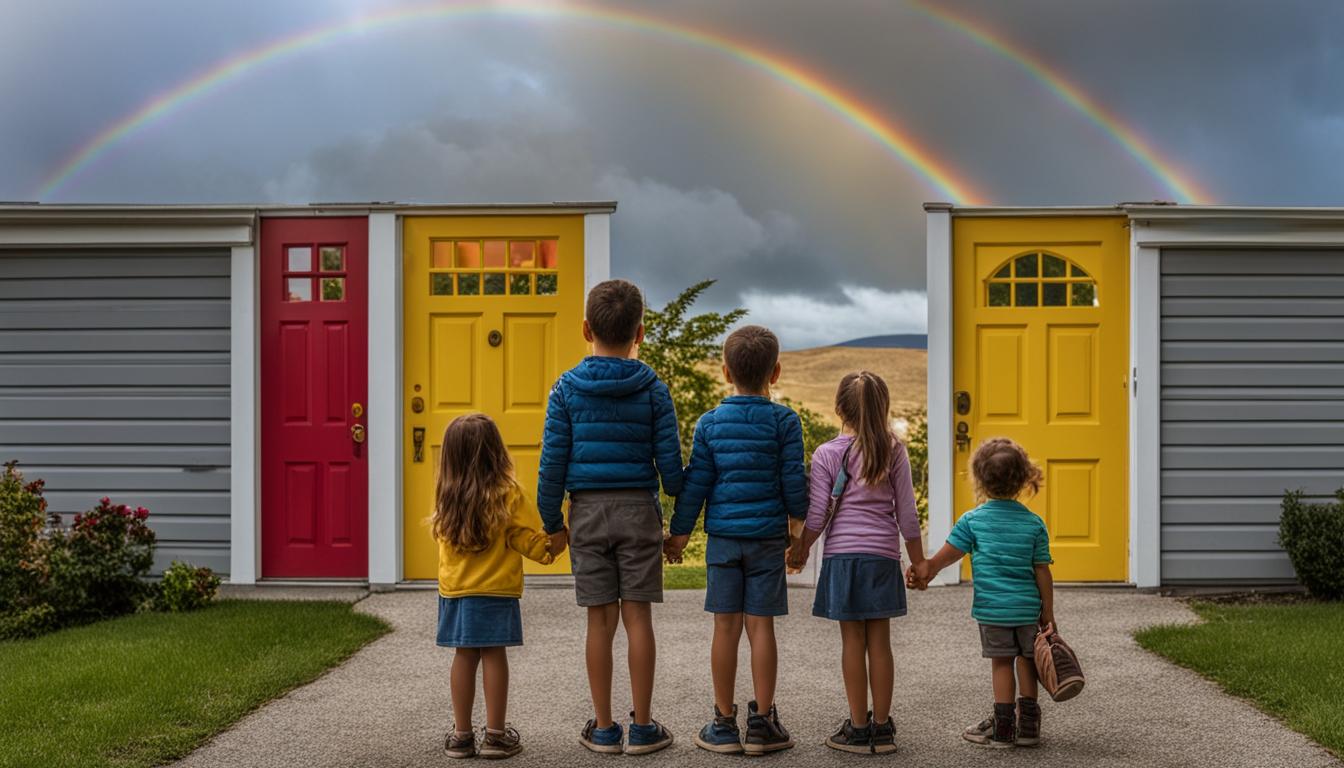Did you know that approximately half of all marriages in the United States end in divorce? This reality often means that many children are forced to navigate the challenges that come with their parents’ separation and the changes that come with it. The impact of divorce on children can have a significant effect on their emotions, behavior, and overall well-being. It is crucial for parents and caregivers to provide the necessary support and resources to help children cope with these difficult circumstances.
Key Takeaways:
- Divorce is a common occurrence in the United States, with approximately 50% of marriages ending in divorce.
- Children of divorced families often face emotional, behavioral, and physical health challenges.
- Parents and caregivers play a vital role in providing support and resources to help children cope with the impact of divorce.
- There are numerous organizations, books, and educational materials available to assist children of divorced families.
- Co-parenting, communication, and seeking outside help are vital components of helping children thrive after divorce.
Understanding the Impact of Divorce on Children
Divorce can have a profound effect on children, disrupting their sense of stability and security. They often experience feelings of guilt and may wrongly believe that they are responsible for their parents’ separation. The effects of divorce can manifest in various ways, including emotional, behavioral, and physical health issues. Understanding these challenges is essential in providing effective support for children and helping them navigate the complexities of divorce.

Research has shown that children of divorced parents are at an increased risk of developing learning and behavioral problems. They may struggle academically and exhibit difficulties in forming and maintaining relationships. The upheaval caused by divorce can also lead to physical health problems, such as sleep disturbances, weakened immune system, and increased vulnerability to chronic illnesses.
“Divorce can disrupt a child’s sense of stability and security, leading to feelings of guilt and a belief that they are to blame for their parents’ separation.”
The emotional impact of divorce on children can manifest as increased aggression, anxiety, and depression. They may experience a rollercoaster of emotions, ranging from anger and sadness to confusion and resentment. In some cases, children may turn to maladaptive coping mechanisms, such as substance abuse, as a way to deal with their emotional turmoil.
The Long-Term Effects of Divorce
The effects of divorce can extend well beyond the immediate aftermath. Studies have shown that children of divorced parents may continue to grapple with the consequences for many years, affecting their overall well-being and life outcomes. They may struggle with trust issues, exhibit difficulties in forming and maintaining intimate relationships, and have a higher likelihood of experiencing divorce themselves in adulthood.
“The effects of divorce can extend well beyond the immediate aftermath, impacting children’s overall well-being and future relationships.”
It is important to recognize that every child’s experience with divorce is unique. While some may adapt more easily, others may require additional support and intervention. By understanding the impact of divorce on children, parents, caregivers, and professionals can work together to provide the necessary resources, guidance, and emotional support to help children navigate this challenging period and promote their long-term resilience and well-being.
Helping Children Cope with Divorce
During the challenging process of divorce, it is important to acknowledge and address the emotional needs of children. Supporting children during this time can help them navigate the changes and express their feelings in healthy ways. Children need to know that they are not alone and that their emotions are valid. Age-appropriate communication and guidance are key to helping children cope with divorce.
One valuable resource that provides support specifically designed for children of divorced families is Rainbows for All Children. Rainbows offers a comprehensive curriculum and programs that help children express their emotions and navigate the grief and turmoil associated with divorce. By participating in Rainbows, children can find solace and peer support, fostering their emotional well-being.

Parents and caregivers play a crucial role in helping children express their feelings during divorce. Open lines of communication and a safe, non-judgmental space can encourage children to share their emotions and concerns. Encouraging children to express themselves through art, play, or journaling can provide additional outlets for their emotions and foster their emotional healing.
Age-Appropriate Resources
Using age-appropriate resources can also aid in helping children cope with divorce. Books such as “It’s Not Your Fault, Koko Bear” by Vicki Lansky and “Dinosaurs Divorce” by Laurene Krasny Brown and Marc Brown can provide children with a sense of validation and understanding. These books offer relatable stories and characters that resonate with children experiencing similar circumstances.
“Books like ‘It’s Not Your Fault, Koko Bear’ and ‘Dinosaurs Divorce’ provide children with a sense of validation and understanding.”
Additionally, counseling services and therapists specializing in supporting children through divorce can offer professional guidance and coping strategies. These professionals can help children navigate their emotions and provide them with tools to cope effectively with the changes brought about by divorce.
Key Points
- Supporting children during divorce is crucial for their emotional well-being.
- Rainbows for All Children offers a specialized curriculum to help children cope with divorce.
- Open lines of communication and age-appropriate resources are key in helping children express their feelings.
- Books such as “It’s Not Your Fault, Koko Bear” and “Dinosaurs Divorce” can provide validation and understanding for children.
- Counseling services and therapists can offer professional guidance and coping strategies for children.
Divorce Resources for Parents
While divorce can be a challenging process, it is important for parents to seek the support they need to navigate this difficult time. Fortunately, there are numerous resources available to provide guidance and assistance to parents during and after divorce. Two organizations that specialize in divorce support services are FamilyKind and Kids In The Middle.
FamilyKind is dedicated to helping families navigate divorce and separation in a healthy and constructive manner. They offer a range of services, including mediation, co-parenting education, and support groups. Through their programs, parents can learn effective communication and co-parenting strategies to ensure the well-being of their children.

Kids In The Middle is another valuable resource for parents going through divorce. They provide education, counseling, and support services for both children and adults. Parents can participate in their co-parenting classes, which focus on improving communication and creating a positive environment for shared parenting. Kids In The Middle also offers individual counseling for parents, aiding them in addressing their own emotional needs and concerns.
By utilizing these divorce support services, parents can access the necessary tools and resources to effectively co-parent and support their children during this challenging transition.
Educational Materials for Children of Divorce
Understanding and processing divorce can be challenging for children. Fortunately, there are various educational materials available that can help them navigate this difficult time. By providing a positive perspective and reassurance, these resources aim to support children and help them feel loved and understood.
Books for Children of Divorce
Books offer a creative and engaging way for children to explore and understand divorce. Two highly recommended titles include:
- Two Homes: This beautifully illustrated book by Claire Masurel highlights the positive aspects of having two homes after a divorce. It emphasizes that love remains constant and that children can feel secure and loved in both households.
- The Invisible String: Written by Patrice Karst, this heartwarming story reassures children that love and connection are not dependent on physical proximity. It helps them understand that even when parents are apart, an invisible string of love binds them together.
These books provide children with valuable insights and a sense of stability during a challenging time. They can also open up opportunities for discussions and help parents address any concerns or questions their children may have.

Educational Brochures
In addition to books, educational brochures can be beneficial resources for children of divorce. A Teen Guide to Divorce” offers age-appropriate information and advice for teenagers navigating their parents’ separation. It covers topics such as coping with emotions, communication strategies, and self-care.
Reputable sources like KidsHealth and U.S. News and World Report also provide articles that offer valuable insights and practical tips for parents on how to support their children through divorce. These resources cover a range of topics, including helping children express their feelings, managing transitions, and fostering healthy co-parenting dynamics.
Educational Materials for Children of Divorce
| Resource | Description |
|---|---|
| Two Homes | A beautifully illustrated book that emphasizes love and stability in two households after divorce. |
| The Invisible String | A heartwarming story that reassures children of the everlasting connection with their parents despite physical separation. |
| “A Teen Guide to Divorce” brochure | An age-appropriate resource providing guidance for teenagers dealing with their parents’ divorce. |
| KidsHealth articles | Reputable articles covering various topics related to children and divorce, providing valuable insights for parents. |
| U.S. News and World Report articles | Informative articles offering practical tips and guidance for parents on supporting children through divorce. |
These educational materials serve as valuable tools in helping children of divorce better understand and cope with the challenges they may face. By offering insights, reassurance, and practical advice, parents can play an active role in supporting their children’s emotional well-being during this transitional period.
Coping Strategies for Children of Divorced Parents
Divorce can be a challenging experience for children, and understanding their reactions and providing appropriate support is crucial. By implementing coping strategies, parents can help their children adjust to the changes and transitions brought on by divorce.
1. Establish Consistent Routines
Consistency and predictability can provide a sense of security and stability for children. Establishing regular routines for daily activities such as mealtimes, bedtime, and homework helps create a structured environment that children can rely on.
2. Provide Structure
Creating a structured environment involves setting clear expectations, boundaries, and guidelines for behavior. Clearly defining rules and consequences helps children understand what is expected of them and promotes a sense of order and consistency.
3. Maintain Open Lines of Communication
Encouraging open and honest communication is essential for children to express their feelings, concerns, and questions about the divorce. By providing a safe space for dialogue, parents can help their children process their emotions and address any misunderstandings or fears they may have.
4. Model Calm and Avoid Conflict
Children look to their parents as role models, and witnessing calm and respectful interactions can help them feel secure and reassured during the divorce process. It is important for parents to avoid engaging in conflicts or speaking negatively about the other parent in front of their children.
5. Encourage Emotional Expression
Children may experience a wide range of emotions during and after the divorce, including sadness, anger, and confusion. Encouraging them to express their feelings through artistic outlets, journaling, or talking to a trusted adult can help them process and cope with their emotions.
| Coping Strategies | Description |
|---|---|
| Establish consistent routines | Provide a sense of stability and predictability through regular daily routines. |
| Provide structure | Set clear expectations and boundaries to create a structured environment. |
| Maintain open lines of communication | Encourage dialogue and create a safe space for children to express their feelings. |
| Model calm and avoid conflict | Set a positive example by handling conflicts peacefully and respectfully. |
| Encourage emotional expression | Support children in expressing their emotions through various outlets. |
By implementing these coping strategies, parents can provide the necessary support and guidance to help their children adjust to the challenges of divorce. Remember, each child may have unique needs, so it’s important to tailor these strategies to fit their individual circumstances.

Seeking Outside Help and Support
Sometimes, children of divorced families and their parents may require additional support to navigate the challenges that come with divorce. Local support groups, counseling services, and therapists can offer invaluable assistance during this difficult time. By accessing professional help, children and families can find the guidance they need to cope with the emotional and practical aspects of divorce.
Local Support Groups
A trustworthy resource for children and parents of divorced families are local support groups. These groups provide a safe and understanding environment where individuals can share their experiences, gain insights, and seek guidance from others who have gone through similar situations. Support groups offer a sense of community and help reduce the feelings of isolation that often accompany divorce.
Counseling Services
Professional counseling services can play a vital role in supporting children and families during the divorce process. Licensed counselors and therapists specialize in helping children express their feelings, cope with changes, and develop healthy strategies to navigate the complex emotions associated with divorce. Through counseling, both children and parents can work towards healing and finding effective solutions.
“Counseling services provide a safe and supportive environment for children and families to address emotional challenges and develop coping mechanisms.”
Therapists
Therapists trained in child psychology and family dynamics can provide personalized support to children of divorced families. These professionals are equipped with the skills to help children process their emotions, manage conflicts, and build resilience. Therapeutic interventions can be instrumental in aiding children’s emotional well-being, promoting healthy adjustment, and facilitating effective communication between parents.

Useful Resources
Here are some reliable resources that offer support and information for children of divorced families:
- The Parent Connection Line: A toll-free helpline offering assistance, guidance, and referrals to parents and caregivers seeking support for children of divorced families.
- Divorce support groups: Various organizations provide resources and facilitate support groups for both parents and children dealing with divorce.
- Websites like DivorceCare: These online platforms serve as valuable resources, offering articles, forums, and online support communities for children and parents.
Addressing Common Concerns and Behaviors
Divorce can be a challenging and confusing time for children, often leading to common worries and changes in behavior. It is important for parents to address these concerns and provide reassurance that the divorce is not their fault. By understanding and addressing these issues, parents can create a stable and comforting environment for their children.
Common Worries During Divorce
During divorce, children may experience various worries and anxieties:
- Feeling responsible: Children might think they caused their parents’ divorce, leading to feelings of guilt and self-blame.
- Fear of abandonment: Children may worry about losing the love and support of one or both parents.
- Anxiety about changes: The disruption of routines and changes in living arrangements can evoke anxiety and uncertainty.
It is crucial for parents to openly communicate with their children and address these worries. Providing reassurance and explanations can help alleviate their concerns and promote a sense of security.
Addressing Children’s Behavior Changes
Divorce can also manifest in changes in children’s behavior. They may exhibit signs of distress or react differently than usual. Some common behavior changes include:
- Acting out: Children may display aggressive behaviors, defiance, or seek attention as a way to cope with their emotions.
- Withdrawal: Other children may become more introverted, isolating themselves from social activities and family interactions.
- Regression: Younger children might revert to earlier developmental stages, such as bedwetting or clinging behaviors.
Parents should respond to these behavior changes with empathy and patience. Providing a nurturing and structured environment can help children regain stability and adapt to the new circumstances.
By addressing common worries and behavior changes, parents can support their children during the divorce process and help them adjust to the changes in their lives. Creating a predictable and structured environment, maintaining consistent household rules, and promptly addressing any signs of anxiety or misbehavior are essential steps in helping children feel secure and cared for.

Tips for Co-Parenting After Divorce
Effective co-parenting is crucial for the well-being of children after divorce. Parents should strive to communicate and cooperate with each other, establish clear custody and visitation arrangements, and create a structured and consistent environment for their children. It is important to refrain from blaming or speaking negatively about the other parent in front of the children, as this can cause emotional harm.
Co-Parenting Tips
- Open Communication: Maintain open and respectful communication with the co-parent. Regularly discuss important matters involving the children and keep each other updated on their well-being.
- Consistency and Routines: Establish consistent rules, expectations, and routines for the children across both households. This helps create stability and a sense of security for the children.
- Flexible Scheduling: Be willing to accommodate changes in the schedule when necessary. Prioritize the children’s needs and be flexible in adjusting visitation arrangements to accommodate special events or unforeseen circumstances.
- Joint Decision-Making: Make important decisions regarding the children together. Involve the co-parent in discussions about education, medical care, extracurricular activities, and other significant aspects of their lives.
- Respect Boundaries: Respect each other’s boundaries and privacy. Avoid prying into the personal lives of the co-parent and refrain from using the children as messengers or spies.
- Positive Communication: Speak positively about the co-parent in front of the children. Avoid making negative remarks or engaging in conflict in their presence. This helps protect the children from unnecessary emotional stress.
- Use a Co-Parenting App: Consider using a co-parenting app or tool to facilitate communication, share important information, and keep track of schedules and expenses related to the children.
Communication During Co-Parenting
Effective communication is essential for successful co-parenting. Here are some tips for maintaining healthy communication with the co-parent:
“Co-parenting requires a high level of communication and cooperation between parents to ensure the well-being of their children. By prioritizing clear and respectful communication, parents can work together to make decisions and provide a nurturing environment for their children.”
To improve communication during co-parenting:
- Choose the Right Medium: Select the most appropriate communication method for different situations. Phone calls or face-to-face meetings may be better for complex discussions, while email or text messages can be used for routine matters.
- Be Respectful and Courteous: Maintain a respectful tone and avoid engaging in arguments or conflicts. Focus on the best interests of the children and strive for a cooperative approach.
- Listen and Validate: Truly listen to the co-parent’s perspective and validate their feelings and concerns. This helps foster understanding and promotes a collaborative environment.
- Keep it Child-Focused: When communicating, prioritize the children’s needs and well-being. Keep the discussions child-focused and avoid bringing up personal grievances or past issues.
- Seek Professional Help: If communication becomes challenging, consider seeking the guidance of a family therapist or mediator. They can provide strategies and support to improve communication and overcome conflicts.
By following these co-parenting tips and maintaining effective communication, parents can create a stable and nurturing environment for their children, even after divorce.
Conclusion
Divorce can be a challenging time for children, but with the right resources and support, they can navigate the changes and build resilience. It is crucial for parents and caregivers to provide a safe and supportive environment, allowing children to express their emotions and offering guidance throughout the process. By accessing appropriate resources and seeking outside help when necessary, parents can help their children adjust and thrive after divorce.
Remember, prioritizing the well-being of both parents and children is fundamental. Co-parenting effectively, establishing clear communication, and creating a consistent and structured environment are key aspects of a successful post-divorce journey. By avoiding blame and negative remarks about the other parent in front of the children, parents can promote a healthy co-parenting relationship and safeguard their children’s emotional well-being.
In conclusion, divorce does not have to define a child’s future. With love, understanding, and the right support, children can overcome the challenges of divorce and develop into resilient individuals. By utilizing the available resources and focusing on open communication, parents can guide their children towards a bright and fulfilling future. Remember, seeking help and prioritizing the well-being of all family members are essential steps towards a successful post-divorce life.
FAQ
What impact does divorce have on children?
Divorce can have significant emotional, behavioral, and physical health effects on children. It can disrupt their sense of stability, increase the risk of learning and behavioral issues, and even lead to problems like aggression and substance abuse.
How can parents help children cope with divorce?
Parents can provide support and guidance to help children navigate the challenges of divorce. Age-appropriate communication, reassurance, and maintaining consistent routines can all be helpful in helping children express their emotions and adjust to the changes.
Are there resources available for divorced parents?
Yes, organizations like FamilyKind and Kids In The Middle offer education and support services for both children and adults experiencing divorce. They provide valuable guidance and counseling to help parents navigate co-parenting challenges and ensure the well-being of their children.
Are there any books or educational materials for children of divorce?
Yes, several books like “Two Homes” and “The Invisible String” help children understand and process divorce. Educational brochures like “A Teen Guide to Divorce” and articles from reputable sources like KidsHealth and U.S. News and World Report offer valuable insights and tips for parents on how to help their children through divorce.
What are some coping strategies for children of divorced parents?
Creating a predictable and structured environment, maintaining open lines of communication, and addressing any signs of anxiety or misbehavior promptly can help children adjust and feel more secure. Additionally, accessing local support groups, counseling services, and therapists can provide valuable assistance for both children and parents.
What should parents do if their children exhibit worrisome behavior during divorce?
It is important for parents to address their children’s concerns and provide reassurance that the divorce is not their fault. Creating a structured and consistent environment, maintaining household rules, and addressing any signs of anxiety or misbehavior promptly can help children adjust and feel more secure.
How can parents effectively co-parent after divorce?
Co-parenting involves clear communication, cooperation, and creating a structured and consistent environment for children. It is important for parents to establish custody and visitation arrangements, refrain from blaming or speaking negatively about the other parent in front of the children, and prioritize the well-being of their children.
What resources are available for children and parents who need additional support?
Local support groups, counseling services, and therapists can provide valuable assistance in helping children and families navigate the challenges of divorce. Resources like the Parent Connection Line, divorce support groups, and websites like DivorceCare offer support and information to those in need.
How can parents address common worries and behaviors in children during divorce?
Addressing children’s concerns and providing reassurance that the divorce is not their fault is crucial. Creating a predictable and structured environment, maintaining consistent household rules, and addressing any signs of anxiety or misbehavior promptly can help children adjust and feel more secure.
What are some tips for successful co-parenting after divorce?
Successful co-parenting involves effective communication, cooperation, and creating a structured and consistent environment for children. It is important to establish clear custody and visitation arrangements, refrain from blaming or speaking negatively about the other parent in front of the children, and prioritize the well-being of the children.










